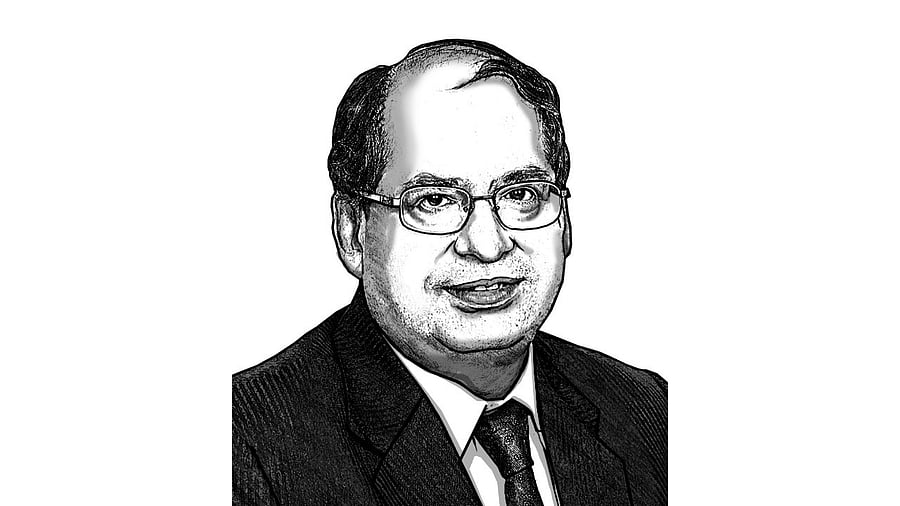
TCA Ranganathan - The former chairman of the Export Import Bank of India is a banker with a theory of everything  @tcartca
Credit: Special Arrangement
Gold prices have been displaying rapid increases, often revealing better returns than stocks to investors, and after touching the Rs-1 lakh mark, are on the way down. However, strangely, the price jump is viewed as concerning though similar stock-price behaviour is celebrated! Admittedly, gold constitutes about 10% of Indian imports. At the same time, however, we need to acknowledge that a substantial number of our high-performing companies are also highly import-dependent.
Our current year import bills are around $650 billion – much higher than our absolute manufacturing size of less than $500 billion. Despite being the fifth largest economy, our global rank as an exporter is in the mid-teens.
The inability of our industrial establishment to compete in the global markets is never viewed as concerning by our analysts. We house the globally largest concentration of tech-facing GCCs and have a globally acclaimed scientific establishment but have not been able to ‘reverse engineer’ any significantly important technology outside space and atomic energy.
This dichotomy of thought about import dependency could perhaps be indicative of the extent of a possible malaise in our economy, that of excessive financialisation.
Financialisation refers to the increase in size and importance of a country’s financial sector relative to its overall economy. A well-functioning financial system can channelise savings into productive investments, reduce transaction costs, and facilitate innovation but its excessive growth can be deleterious. It involves a shift in attitudes where economic value is primarily derived from financial activities – trading stocks, bonds, derivatives, and other financial assets – rather than traditional productive activities like manufacturing or services.
Companies and individuals prioritise financial investments and speculative activities, essentially to reap short-term financial gains over productive long-term investments in research, development, or employee welfare, undermining sustainable growth. The Economic Survey (2024-25) was amongst the earliest to caution that rapid financial market growth without corresponding economic growth could end up harming India, citing risks of inequality, debt, and over-reliance on asset prices.
We need to view the changing global order. Donald Trump’s second presidency is unsettling; turbulence in asset marketplaces is a natural corollary. This is, however, only one aspect of the overall turmoil in global thought unleashed by Trump. His very emergence was driven by underlying socio-economic trends. The creation of a unipolar world after the Cold War had created a belief that ‘Geography is now History’. Alongside, the revolutionary progress in informatics and transportation technologies resulted in unprecedented globalisation of manufacturing locations and skills. Profitability, efficiency, and sustainability became the new catchwords. In this milieu, sharp geographical differences in national per capita income assumed gravitational power. As a consequence, significant geographical variations in ‘new job creation’ emerged. This environment generated widespread growth and prosperity in the emerging markets but concomitantly created distress in some sections of the developed countries.
Additionally, a new geographical concentration of technological and scientific prowess occurred. Most high-tech manufacturing equipment, components and related automation systems are now China-made. The most visible technological progress in several technologically advanced industrial sectors now seem to be China-based. The unipolar governance model is also now broken. Xi Jinping’s absorption with an early fulfilling of the ‘100-year Chinese dream’ provoked the initial US-China trade war under Trump’s first presidency, but which noticeably continued even after he demitted office.
The flavour of the US’ domestic politics, the rise of MAGA, Trump’s historic return to presidency, and the resultant pyrotechnics are all in a sense symptomatic of the emergence of a new order. Alongside, however, the so-far successful Chinese response to Trump has revealed the dangers of excessive Chinese dependence. Their decision not to allow exports of rare earth mineral concentrates/products, a tiny but critical ingredient, has created threats to the smooth maintenance of the new-age digital ecosystem. Similar denial in other vitally important products has also been signalled.
The Chinese stock markets have not given anywhere equivalent returns in comparison to Indian markets. But it could be that it is our preoccupation with profit margins and return ratios that confined Indian companies to low or medium technology segments, making us industrially weak though financially glittering. China, on the other hand, has created a large number of independently competitive global-sized companies in major new technology spaces such as EVs, robotics, solar, battery, aeronautical, and defence and is able to swamp the world with their produce, generating about a trillion USD annual surplus.
In this new emerging ‘each country for itself’ world order, decisions based on financial market imperatives may not always be sensible for national security. We need to debate whether our current package of fiscal and attitudinal signals is still sensible or whether we should now be more ‘real economy’-focussed.